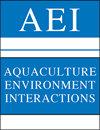Spatial epidemiological modelling of infection by Vibrio aestuarianus shows that connectivity and temperature control oyster mortality
IF 2.5
2区 农林科学
Q2 FISHERIES
引用次数: 4
Abstract
Vibrio aestuarianus infection in oyster populations causes massive mortality, resulting in losses for oyster farmers. Such dynamics result from host-pathogen interactions and contagion through water-borne transmission. To assess the spatiotemporal spread of V. aestuarianus infection and associated oyster mortality at a bay scale, we built a mathematical model informed by experimental infection data at 2 temperatures and spatially dependent marine connectivity of oyster farms. We applied the model to a real system and tested the importance of each factor using a number of modelling scenarios. Results suggest that introducing V. aestuarianus in a fully susceptible adult oyster population in the bay would lead to the mortality of all farmed oysters over 6 to 12 mo, depending on the location in which infection was initiated. The effect of temperature was captured by the basic reproduction number (R0), which was >1 at high seawater temperatures, as opposed to values <1 at low temperatures. At the ecosystem scale, simulations showed the existence of long-distance dispersal of free-living bacteria. The western part of the bay could be reached by bacteria originating from the eastern side, though the spread time was greatly increased. Further developments of the model, including the consideration of the anthropogenic movements of oysters and oyster-specific sensitivity factors, would allow the development of accurate maps of epidemiological risks and help define aquaculture zoning.牡蛎弧菌感染的空间流行病学模型表明,连通性和温度控制牡蛎死亡
牡蛎种群中的牡蛎弧菌感染会导致大量死亡,给牡蛎养殖者造成损失。这种动态是由宿主-病原体相互作用和通过水传播的传染造成的。为了评估海湾尺度上aestuarianus V.感染的时空传播和相关的牡蛎死亡率,我们根据2种温度下的实验感染数据和牡蛎养殖场的空间依赖性海洋连通性建立了数学模型。我们将该模型应用于实际系统,并使用多个建模场景测试每个因素的重要性。结果表明,在海湾中完全易感的成年牡蛎种群中引入aestuarianus将导致所有养殖牡蛎在6至12个月期间死亡,这取决于感染发生的地点。温度的影响体现在基本繁殖数(R0)上,海水温度高时R0为>1,而海水温度低时R0 <1。在生态系统尺度上,模拟显示了自由生活细菌长距离传播的存在。来自东侧的细菌可以到达海湾西部,但传播时间大大增加。该模型的进一步发展,包括考虑到牡蛎的人为运动和牡蛎特有的敏感性因素,将有助于制定准确的流行病学风险地图,并有助于确定水产养殖分区。
本文章由计算机程序翻译,如有差异,请以英文原文为准。
求助全文
约1分钟内获得全文
求助全文
来源期刊

Aquaculture Environment Interactions
FISHERIES-MARINE & FRESHWATER BIOLOGY
CiteScore
4.90
自引率
13.60%
发文量
15
审稿时长
>12 weeks
期刊介绍:
AEI presents rigorously refereed and carefully selected Research Articles, Reviews and Notes, as well as Comments/Reply Comments (for details see MEPS 228:1), Theme Sections and Opinion Pieces. For details consult the Guidelines for Authors. Papers may be concerned with interactions between aquaculture and the environment from local to ecosystem scales, at all levels of organisation and investigation. Areas covered include:
-Pollution and nutrient inputs; bio-accumulation and impacts of chemical compounds used in aquaculture.
-Effects on benthic and pelagic assemblages or processes that are related to aquaculture activities.
-Interactions of wild fauna (invertebrates, fishes, birds, mammals) with aquaculture activities; genetic impacts on wild populations.
-Parasite and pathogen interactions between farmed and wild stocks.
-Comparisons of the environmental effects of traditional and organic aquaculture.
-Introductions of alien species; escape and intentional releases (seeding) of cultured organisms into the wild.
-Effects of capture-based aquaculture (ranching).
-Interactions of aquaculture installations with biofouling organisms and consequences of biofouling control measures.
-Integrated multi-trophic aquaculture; comparisons of re-circulation and ‘open’ systems.
-Effects of climate change and environmental variability on aquaculture activities.
-Modelling of aquaculture–environment interactions; assessment of carrying capacity.
-Interactions between aquaculture and other industries (e.g. tourism, fisheries, transport).
-Policy and practice of aquaculture regulation directed towards environmental management; site selection, spatial planning, Integrated Coastal Zone Management, and eco-ethics.
 求助内容:
求助内容: 应助结果提醒方式:
应助结果提醒方式:


